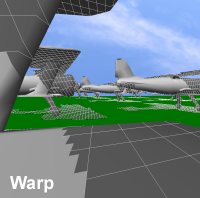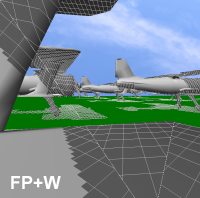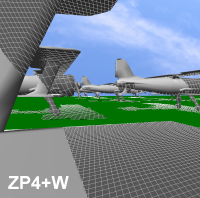



Brandon Lloyd, David Tuft, Sung-Eui Yoon, Dinesh Manocha
University of North Carolina at Chapel Hill
In Proceedings of the Eurographics Symposium on Rendering 2006

|

|

|

|
Two approaches for reducing perspective aliasing with shadow maps are 1) warping the shadow map and 2) partitioning the scene and using multiple shadow maps. (Std.) A standard shadow map. (Warp) A warping scheme (LSPSM) reduces aliasing. (FP+W) The view frustum is partitioned according to the faces visible to the light (face partitioning) and a warp is applied to the shadow map for each partition. (ZP4+W) The view frustum is subdivided into four sub-frusta along its view axis (z-partitioning) and a warp is applied to each. The error is lowest for the z-partitioning scheme. The same total amount of texture memory is used for all the shadow maps combined in each image (1024x1024). The images are 1024x1024. The projected grid lines are five shadow map texels apart. The frame rates from left to right are 143, 143, 115, and 107 fps.
We evaluate several shadow map algorithms based on warping and partitioning using the maximum perspective aliasing error over the entire view frustum. With respect to our error metric, we show that a range of warping parameters corresponding to several previous warping algorithms have the same error. We also analyze several partitioning schemes to determine which produces the least maximum error using the least number of partitions. Finally, we show how warping and partitioning can be combined for interactive rendering of low error shadows in scenes with a high depth range.
Note: There seems to be some confusion about the equivalence of warping parameters in terms of storage factor holds for general light positions. For general light positions the derived error equations are no longer valid, and the equivalence no longer holds. Regrettably, the paper can easily be read as implying that the equivalence holds in all cases and is not as clear on this point as it could have been. For warping applied to face partitions, however, the equivalence holds true even for general light positions.